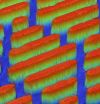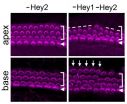(Press-News.org) Transmission of bacterial infections, including MRSA and MSSA could be curbed by coating hospital surfaces with microscopic bumps that mimic the scaly surface of shark skin, according to research published in the open access journal Antimicrobial Resistance and Infection Control.
The study modelled how well different materials prevented the spread of human disease bacteria through touching, sneezes or spillages. The micropattern, named Sharklet™, is an arrangement of ridges formulated to resemble shark skin. The study showed that Sharklet harboured 94% less MRSA bacteria than a smooth surface, and fared better than copper, a leading antimicrobial material. The bacteria were less able to attach to Sharklet's imperceptibly textured surface, suggesting it could reduce the spread of superbugs in hospital settings.
The surfaces in hospitals and healthcare settings are often rife with bacteria and patients are vulnerable to bacterial infection. Scientists are investigating the ability of different materials to prevent the spread of bacteria. Copper alloys are a popular option, as they are toxic to bacterial cells, interfering with their cellular processes and killing them. The Sharklet micropattern works differently – the size and composition of its microscopic features prevent bacteria from attaching to it. It mimics the unique qualities of shark skin, which, unlike other underwater surfaces, inhibits bacteria, because it is covered with a natural micropattern of tooth-like structures, called denticles.
Dr Ethan Mann, a research scientist at Sharklet Technologies, the manufacturer of the micropattern, says: "The Sharklet texture is designed to be manufactured directly into the surfaces of plastic products that surround patients in hospital, including environmental surfaces as well as medical devices. Sharklet does not introduce new materials or coatings – it simply alters the shape and texture of existing materials to create surface properties that are unfavorable for bacterial contamination."
The researchers from Sharklet Technologies compared how well two types of infection-causing bacteria, methicillin-resistant or susceptible Staphylococcus aureus (MRSA and MSSA), fared at contaminating three surfaces - the Sharklet micropattern, a copper alloy, and a smooth control surface. They created experimental procedures to mimic common ways bacteria infect surfaces. Sneezing was mimicked by using a paint sprayer to spread the bacterial solution on 10 samples of each surface. To mimic infected patients touching the surfaces, velveteen cloth was put in contact with bacteria for 10s, and then placed on another set of each test surface for 10s. A third set of each surface was immersed in bacterial solution for an hour, then rinsed and dried, to mimic spills.
Surfaces were sampled for remaining contaminations either immediately following exposure to MSSA and MRSA or 90 minutes after being exposed. The Sharklet micropattern reduced transmission of MSSA by 97% compared to the smooth control, while copper was no better than the control. The micropattern also harboured 94% less MRSA bacteria than the control surface, while the copper had 80% less.
Dr Mann says: "Shark skin itself is not an antimicrobial surface, rather it seems highly adapted to resist attachment of living organisms such as algae and barnacles. Shark skin has a specific roughness and certain properties that deter marine organisms from attaching to the skin surface. We have learned much from nature in building this material texture for the future."
INFORMATION:
Citation
Surface micropattern limits bacterial contamination
Ethan E Mann, Dipankar Manna, Michael R Mettetal, Rhea M May, Elisa M Dannemiller, Kenneth K Chung, Anthony B Brennan and Shravanthi T Reddy
Antimicrobial Resistance and Infection Control 2014, 3: 28
Please contact Anna Perman (anna.perman@biomedcentral.com) for a copy of the paper
After embargo, article available at journal website here:
http://www.aricjournal.com/content/3/1/28
Please name the journal in any story you write. If you are writing for the web, please link to the article. All articles are available free of charge, according to BioMed Central's open access policy.
Antimicrobial Resistance and Infection Control is a global forum for reports encompassing all aspects of resistance development and prevention of health-care associated infections in all health-care settings.
BioMed Central is an STM (Science, Technology and Medicine) publisher which has pioneered the open access publishing model. All peer-reviewed research articles published by BioMed Central are made immediately and freely accessible online, and are licensed to allow redistribution and reuse. BioMed Central is part of Springer Science+Business Media, a leading global publisher in the STM sector.
Sharks' skin has teeth in the fight against hospital superbugs
2014-09-17
ELSE PRESS RELEASES FROM THIS DATE:
Violent origins of disc galaxies probed by ALMA
2014-09-17
An international research group led by Junko Ueda, a Japan Society for the Promotion of Science postdoctoral fellow, has made surprising observations that most galaxy collisions in the nearby Universe — within 40 million light-years from Earth — result in so-called disc galaxies. Disc galaxies — including spiral galaxies like the Milky Way and lenticular galaxies — are defined by pancake-shaped regions of dust and gas, and are distinct from the category of elliptical galaxies.
It has, for some time, been widely accepted that merging disc galaxies would eventually form ...
Global shift away from cars saves US$100 trillion, eliminates 1,700 MT of CO2 pollution
2014-09-17
NEW YORK (17 September, 2014)—More than $100 trillion in cumulative public and private spending, and 1,700 megatons of annual carbon dioxide (CO2)—a 40 percent reduction of urban passenger transport emissions—could be eliminated by 2050 if the world expands public transportation, walking and cycling in cities, according to a new report released by the University of California, Davis, and the Institute for Transportation and Development Policy (ITDP).
Further, an estimated 1.4 million early deaths could be avoided annually by 2050 if governments require the strongest ...
'Smart material' chin strap harvests energy from chewing
2014-09-17
A chin strap that can harvest energy from jaw movements has been created by a group of researchers in Canada.
It is hoped that the device can generate electricity from eating, chewing and talking, and power a number of small-scale implantable or wearable electronic devices, such as hearing aids, cochlear implants, electronic hearing protectors and communication devices.
The first results of the device's performance have been published today, 17 September, in IOP Publishing's journal Smart Materials and Structures.
Jaw movements have proved to be one of the most promising ...
World Alzheimer Report 2014 reveals persuasive evidence for dementia risk reduction
2014-09-17
The World Alzheimer Report 2014 'Dementia and Risk Reduction: An analysis of protective and modifiable factors', released today, calls for dementia to be integrated into both global and national public health programmes alongside other major non communicable diseases (NCDs).
Alzheimer's Disease International (ADI) commissioned a team of researchers, led by Professor Martin Prince from King's College London, to produce the report. ADI is publishing this report, in conjunction with World Alzheimer's Day™ (21 September) and as a part of World Alzheimer's Month, an international ...
Diabetes complications make patients more likely to fall down stairs
2014-09-17
New research presented at this year's annual meeting of the European Association for the Study of Diabetes (EASD) in Vienna, Austria, shows that people suffering from diabetic peripheral neuropathy (DPN)—a complication of diabetes that affects the nerves in the limbs—are likely to sway more during stair climbing, and thus are more likely to fall. Steven Brown, Manchester Metropolitan University, UK, is the lead author on this research, which has been conducted by researchers at Manchester Metropolitan University and the University of Manchester, UK.
Patients with DPN ...
Study shows users of insulin pumps are at 29 percent lower risk of death compared with patients on insulin injections
2014-09-17
A study of more than 18,000 patients with type 1 diabetes has shown that use of insulin pumps to administer insulin rather than treatment with multiple daily insulin injections results in a 29% reduction in all-cause mortality and 43% reduction in the risk of fatal cardiovascular disease (CVD, i.e. coronary heart disease or stroke). The study is presented at the annual meeting of the European Association for the Study of Diabetes in Vienna, Austria, and was prepared by Dr Soffia Gudbjörnsdottir, University of Gothenburg, Sweden and colleagues.
Insulin pump treatment (CSII ...
The Lancet: Scientists use modern forensic techniques to identify most likely cause of King Richard III's death
2014-09-17
New research led by the University of Leicester in the UK gives a blow-by-blow account of the injuries inflicted on King Richard III's body at the Battle of Bosworth Field on Aug 22, 1485. Modern forensic analysis of the King's skeletal remains reveals that three of his injuries had the potential to cause death quickly—two to the skull (page 4, figure 4) and one to the pelvis (page 5, figure 6).
The remains of King Richard III—the last English monarch to die in battle—were found under a car park in Leicester by archaeologists from the University of Leicester, and subsequently ...
Urine HPV test could offer non-invasive alternative to conventional smear, improve screening uptake
2014-09-17
Human papillomavirus (HPV) is one of the most common sexually transmitted infections. Up to 80% of sexually active women are infected at some point in their lives and infection with specific "high risk" strains of HPV has an established link to cervical cancer.
Current screening by cervical cytology (smear test) is invasive and time-consuming - and in recent years, cervical screening in the UK has fallen below 80%, particularly amongst women aged 25-30. Several studies have suggested that detecting HPV in urine may be a feasible alternative to cervical sampling, but the ...
Hey1 and Hey2 ensure inner ear 'hair cells' are made at the right time, in the right place
2014-09-17
Two Johns Hopkins neuroscientists have discovered the "molecular brakes" that time the generation of important cells in the inner ear cochleas of mice. These "hair cells" translate sound waves into electrical signals that are carried to the brain and are interpreted as sounds. If the arrangement of the cells is disordered, hearing is impaired.
A summary of the research will be published in The Journal of Neuroscience on Sept. 16.
"The proteins Hey1 and Hey2 act as brakes to prevent hair cell generation until the time is right," says Angelika Doetzlhofer, Ph.D., an ...
36 Pit Fire in Oregon
2014-09-17
The 36 Pit Fire began on September 13, 2014. The fire is human-caused and is still under investigation. It is currently over 2,300 acres in size and is mostly being fueled by grass and timber. The 36 Pit Fire was calm Monday night due to higher humidity. Yesterday (8/15), firefighters made progress in establishing an anchor point and beginning to construct a fireline on the West and North sides of the fire.
The following resources are working on the fire:
7 20-person Crews
4 Hot Shot Crews
1 large Type 1 Helicopter
2 medium Type 2 Helicopter
2 bulldozer
17 ...




